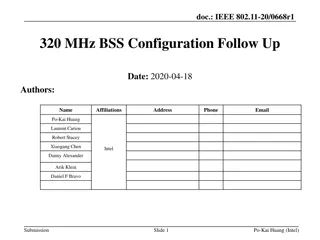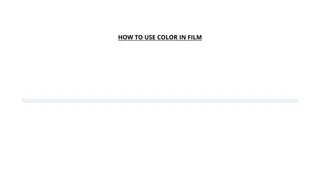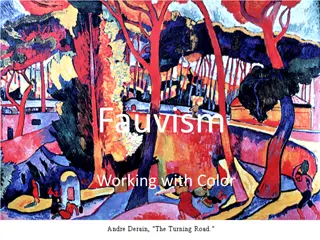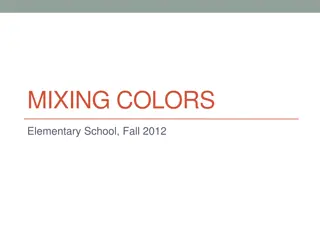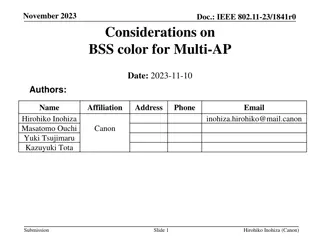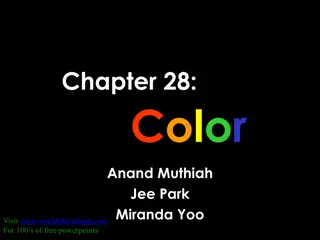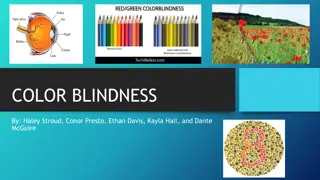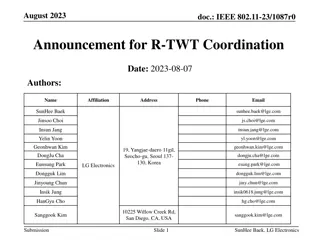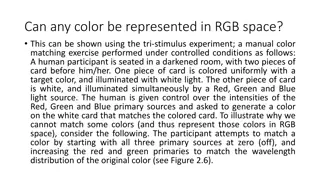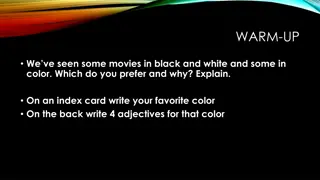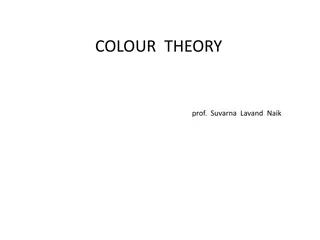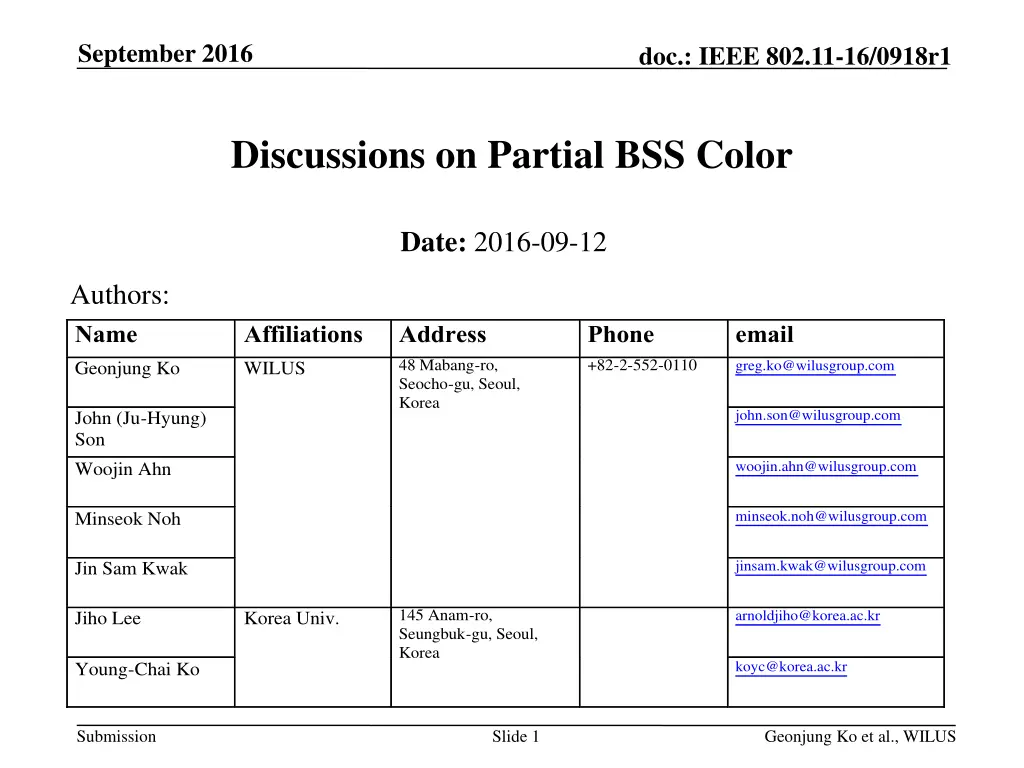
IEEE 802.11-16/0918r1 Partial BSS Color Discussions
Explore the discussions on Partial BSS Color in IEEE 802.11-16/0918r1 document from September 2016. The document delves into the concept of Partial AID (PAID) and its reflection in VHT PPDU, enabling spatial reuse transmission within a BSS. Discover the AID assignment rules, ambiguity in PAID field, and solutions proposed in the revised version of the document.
Download Presentation

Please find below an Image/Link to download the presentation.
The content on the website is provided AS IS for your information and personal use only. It may not be sold, licensed, or shared on other websites without obtaining consent from the author. If you encounter any issues during the download, it is possible that the publisher has removed the file from their server.
You are allowed to download the files provided on this website for personal or commercial use, subject to the condition that they are used lawfully. All files are the property of their respective owners.
The content on the website is provided AS IS for your information and personal use only. It may not be sold, licensed, or shared on other websites without obtaining consent from the author.
E N D
Presentation Transcript
September 2016 doc.: IEEE 802.11-16/0918r1 Discussions on Partial BSS Color Date: 2016-09-12 Authors: Name Affiliations Address 48 Mabang-ro, Seocho-gu, Seoul, Korea Phone +82-2-552-0110 email greg.ko@wilusgroup.com Geonjung Ko WILUS john.son@wilusgroup.com John (Ju-Hyung) Son Woojin Ahn woojin.ahn@wilusgroup.com minseok.noh@wilusgroup.com Minseok Noh jinsam.kwak@wilusgroup.com Jin Sam Kwak 145 Anam-ro, Seungbuk-gu, Seoul, Korea arnoldjiho@korea.ac.kr Jiho Lee Korea Univ. koyc@korea.ac.kr Young-Chai Ko Submission Slide 1 Geonjung Ko et al., WILUS
September 2016 doc.: IEEE 802.11-16/0918r1 Introduction AID assignment rule has been defined in 11ax [1]. AID assigned by the rule is reflected in Partial AID (PAID) field in VHT PPDU, especially for SU DL case. The part of the PAID becomes the partial BSS color. By using PAID field, a STA can determine whether the VHT PPDU is intra-BSS. Spatial reuse transmission is possible. For certain BSSIDs, one BSS may have two partial BSS color values following the rule. The initial version (July 2016) of the contribution addressed the problem. The revised version (September 2016) includes the possible solutions and discusses on them. Submission Slide 2 Geonjung Ko et al., WILUS
September 2016 doc.: IEEE 802.11-16/0918r1 Recap: AID Assignment Rule (1) [2] AP assigns AIDs to associated STAs according to - - - N = 1, 2, 3 or 4 BCB: (Partial) BSS Color Bits A TBD IE contains N and BCB. Settings for PAID field in VHT PPDU Uplink Downlink Submission Slide 3 Geonjung Ko et al., WILUS
September 2016 doc.: IEEE 802.11-16/0918r1 Recap: AID Assignment Rule (2) [2] Then the PAID(8 N+1:8) automatically becomes the partial BSS color. * PAID for DL PAID = (dec(AID[0:8]) + dec(BSSID[44:47] XOR BSSID[40:43]) * 25) mod 29 * AID assignment rule AID[8 N+1:8] = bin[(dec(BCB[0:N 1]) + dec(BSSID[47 N+1:47] XOR BSSID[43 N+1:43])) mod 2N, N] Spatial reuse transmission is possible on the VHT PPDU by using PAID field. Submission Slide 4 Geonjung Ko et al., WILUS
September 2016 doc.: IEEE 802.11-16/0918r1 Ambiguity in PAID Field One BSS may have two PAID[8 N+1:8] values. N-bit assigned by the rule x B8 B7 B6 B5 B4 B3 B2 B1 B0 y B8 B7 B6 B5 B4 B3 B2 B1 B0 + z mod 29 (Cutting off B9) 00000 due to * 25 PAID B8 B7 B6 B5 B4 B3 B2 B1 B0 x y * PAID for DL Partial BSS color (N-bit) - Higher N bits of x only depend on the BSS. - y only depends on the BSS. PAID = (dec(AID[0:8]) + dec(BSSID[44:47] XOR BSSID[40:43]) * 25) mod 29 z * AID assignment rule AID[8 N+1:8] = bin[(dec(BCB[0:N 1]) + dec(BSSID[47 N+1:47] XOR BSSID[43 N+1:43])) mod 2N, N] When the addition is performed, For N < 4, 1 can be rounded up from the bit position (8 N+1 1) For example, N = 3, if B5 of y is 1, B5 of AID is 0 or 1 0: No rounding / 1: Rounding Two PAID[6:8] values For N = 4, there is no rounding from B4 since y[0:4] is always b00000. No ambiguity Submission Slide 5 Geonjung Ko et al., WILUS
September 2016 doc.: IEEE 802.11-16/0918r1 Ambiguity Example (Details in Appendix) HE AP BSSID Frame carrying TBD IE VHT PPDU xx:xx:xx:xx:xx:5B Including PAID PAID AP cannot receive a PPDU. 1 0 1 0 0 0 0 0 0 VHT STA AID[0:8] b001100000 Interference TBD IE carrying N and BCB - N = 3 - BCB[0:N 1] = b110 HE STA AID[0:8] b001000011 Spatial Reuse Transmission HE STA calculates BSS s PAID[8 N+1:8] PAID 1 0 0 1 0 0 0 1 1 Different PAID[8 N+1:8] : If the HE STA compares PAID[8 N+1:8] values, an intra-BSS frame is identified as inter-BSS. * PAID for DL PAID = (dec(AID[0:8]) + dec(BSSID[44:47] XOR BSSID[40:43]) * 25) mod 29 * AID assignment rule AID[6:8] = b001 AID[8 N+1:8] = bin[(dec(BCB[0:N 1]) + dec(BSSID[47 N+1:47] XOR BSSID[43 N+1:43])) mod 2N, N] Submission Slide 6 Geonjung Ko et al., WILUS
September 2016 doc.: IEEE 802.11-16/0918r1 Issues on the Current Rule * AID assignment rule in SFD AID[8 N+1:8] = bin[(dec(BCB[0:N 1]) + dec(BSSID[47 N+1:47] XOR BSSID[43 N+1:43])) mod 2N, N], where N is 1, 2, 3, or 4 N-bit assigned by the rule x B8 B7 B6 B5 B4 B3 B2 B1 B0 y B8 B7 B6 B5 B4 B3 B2 B1 B0 + 00000 due to * 25 z PAID B8 B7 B6 B5 B4 B3 B2 B1 B0 x y * PAID for DL Issue 1: Ambiguity by rounding up PAID = (dec(AID[0:8]) + dec(BSSID[44:47] XOR BSSID[40:43]) * 25) mod 29 Issue 2: A BSS identifier not equal to BCB z Issue 1: Ambiguity in PAID[8 N+1:8] For N < 4, sometimes rounding up and sometimes no rounding up from the bit position (8 N+1) for a BSS in the PAID calculation. Issue 2: PAID[8 N+1:8] not equal to the partial BSS Color Modifying (+) operation to ( ) operation results in PAID[8 N+1:8] = BCB[0:N 1]. Without this modification, the STA needs more calculation for the determination using PAID. Submission Slide 7 Geonjung Ko et al., WILUS
September 2016 doc.: IEEE 802.11-16/0918r1 Possible Solutions: Option 1 Restricting N to 4 AID[8 N+1:8] = bin[(dec(BCB[0:N 1]) dec(BSSID[47 N+1:47] XOR BSSID[43 N+1:43])) mod 2N, N] where N = 4 2) Matching PAID and BCB 1) No ambiguity That is, AID[5:8] = bin[(dec(BCB[0:3]) dec(BSSID[44:47] XOR BSSID[40:43])) mod 24, 4] 1) No ambiguity 4-bit assigned by the rule x B8 B7 B6 B5 B4 B3 B2 B1 B0 y B8 B7 B6 B5 B4 B3 B2 B1 B0 + 00000 due to * 25 z mod 29 (Cutting off B9) PAID B8 B7 B6 B5 B4 B3 B2 B1 B0 2) Matching PAID and BCB BCB (N-bit) x y * PAID for DL PAID = (dec(AID[0:8]) + dec(BSSID[44:47] XOR BSSID[40:43]) * 25) mod 29 z Submission Slide 8 Geonjung Ko et al., WILUS
September 2016 doc.: IEEE 802.11-16/0918r1 Possible Solutions: Option 2 Changing the bit position of AID assignment AID[5:5+N 1] = bin[(dec(BCB[0:N 1]) dec(BSSID[44:44+N 1] XOR BSSID[40:40+N 1])) mod 2N, N] where N = 1, 2, 3, or 4 2) Matching PAID and BCB 1) No ambiguity 1) No ambiguity N-bit assigned by the rule x B8 B7 B6 B5 B4 B3 B2 B1 B0 y B8 B7 B6 B5 B4 B3 B2 B1 B0 + 00000 due to * 25 z mod 29 (Cutting off B9) PAID B8 B7 B6 B5 B4 B3 B2 B1 B0 2) Matching PAID and BCB BCB (N-bit) x y * PAID for DL PAID = (dec(AID[0:8]) + dec(BSSID[44:47] XOR BSSID[40:43]) * 25) mod 29 z Submission Slide 9 Geonjung Ko et al., WILUS
September 2016 doc.: IEEE 802.11-16/0918r1 Discussions on Possible Solutions We prefer Option 2. According to the SFD, the number of partial BSS color bits N is chosen among 1, 2, 3, and 4. It is not fixed [1]. The number of STAs that can be associated (Option 1) The number is restricted to less than 2(11 4) = 128. (Option 2) The flexibility is allowed. The number can be more than 128 (for N < 4). The TIM element overhead (Option 1) If two STAs are allocated in different AID blocks, the AIDs of STAs are apart about 29 = 512 bits each other. The maximum number of continuous AIDs is 32. (Option 2) If N = 4, it is the same with Option 1. If N < 4, the overhead can be smaller than Option 1 (The distance between AID blocks corresponds to 26, 27, or 28.). The maximum number of continuous AIDs is 32. Submission Slide 10 Geonjung Ko et al., WILUS
September 2016 doc.: IEEE 802.11-16/0918r1 Conclusions Due to the ambiguity using PAID for partial BSS color, an HE STA may identify an intra-BSS VHT PPDU as inter-BSS. Then, the HE STA may transmit a packet using OBSS PD level which interferes the intra-BSS PPDU. The spec should further consider the BSS color ambiguity of PAID in VHT PPDU when Partial BSS Color Length N is less than 4. Possible solutions have been discussed. We propose to use Option 2. It has the flexibility for choosing N and the spec does not need to limit the flexibility. Submission Slide 11 Geonjung Ko et al., WILUS
September 2016 doc.: IEEE 802.11-16/0918r1 References [1] 11-15/0132r17 Specification Framework for TGax [2] 11-16/0364r3 AID Assign Rule Based on BSS Color and HE Operation Element Submission Slide 12 Geonjung Ko et al., WILUS
September 2016 doc.: IEEE 802.11-16/0918r1 Straw Poll Do you agree to adopt the spec text change as shown in doc 11-16/1236r0? Y N A Submission Slide 13 Geonjung Ko et al., WILUS
September 2016 doc.: IEEE 802.11-16/0918r1 Appendix: Detailed Example HE AP BSSID Frame carrying TBD IE VHT PPDU xx:xx:xx:xx:xx:5B B47 B46 B45 B44 B43 B42 B41 B40 1 0 1 0 Including PAID AP cannot receive a PPDU. x y z 0 0 1 1 0 0 0 0 0 1 1 0 1 + 0 1 1 1 0 0 0 0 0 1 0 1 0 0 0 0 0 0 1 0 1 0 0 0 0 0 0 mod 29 VHT STA AID[0:8] b001100000 PAID Interference TBD IE carrying N and BCB - N = 3 - BCB[0:N 1] = b110 HE STA AID[0:8] b001000011 Spatial Reuse Transmission HE STA calculates BSS s PAID[8 N+1:8] x y + z 1 0 0 1 0 0 0 1 1 1 0 0 1 0 0 0 1 1 0 0 1 0 0 0 0 1 1 0 1 1 1 0 0 0 0 0 Different PAID[8 N+1:8] : If the HE STA compares PAID[8 N+1:8] values, an intra-BSS frame is identified as inter-BSS. mod 29 PAID x y * PAID for DL PAID = (dec(AID[0:8]) + dec(BSSID[44:47] XOR BSSID[40:43]) * 25) mod 29 z * AID assignment rule AID[6:8] = bin[(6 + dec(b101 XOR 110)) mod 23, 3] = bin[(6 + dec(b011)) mod 23, 3] = bin[9 mod 23, 3] = bin[1, 3] = b001 AID[8 N+1:8] = bin[(dec(BCB[0:N 1]) + dec(BSSID[47 N+1:47] XOR BSSID[43 N+1:43])) mod 2N, N] Submission Slide 14 Geonjung Ko et al., WILUS



